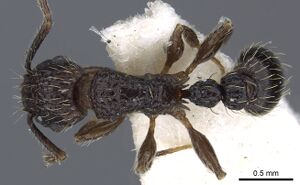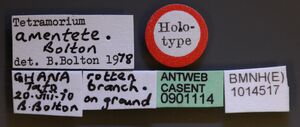Tetramorium amentete
| Tetramorium amentete | |
|---|---|

| |
| Scientific classification | |
| Kingdom: | Animalia |
| Phylum: | Arthropoda |
| Class: | Insecta |
| Order: | Hymenoptera |
| Family: | Formicidae |
| Subfamily: | Myrmicinae |
| Tribe: | Crematogastrini |
| Genus: | Tetramorium |
| Species: | T. amentete |
| Binomial name | |
| Tetramorium amentete Bolton, 1980 | |
The type series was taken from a rotten stick on the ground, while another record is from a soil nest. Other collections were taken from the litter, ground surface, and soil in primary and disturbed forests.
Identification
Bolton (1980) - A member of the T. bicarinatum species complex in the Tetramorium bicarinatum species group. This small, darkly coloured species is closest related to Tetramorium pullulum, but in this latter species the pedicel segments are unsculptured and smooth dorsally, the alitrunk has extensive unsculptured areas and the costulae of the first gastral tergite which are so distinctive in T. amentete are faint and replaced to a great extent by punctulation in T. pullulum. The two other small species in this group, Tetramorium phasias and Tetramorium peutli, both have the head and alitrunk yellow or orange, in the case of T. peutli this colour contrasting with the dark brown or black gaster.
Keys including this Species
Distribution
Latitudinal Distribution Pattern
Latitudinal Range: 6.5° to 6.216666667°.
| North Temperate |
North Subtropical |
Tropical | South Subtropical |
South Temperate |
- Source: AntMaps
Distribution based on Regional Taxon Lists
Afrotropical Region: Ghana (type locality), Ivory Coast.
Distribution based on AntMaps
Distribution based on AntWeb specimens
Check data from AntWeb
Countries Occupied
| Number of countries occupied by this species based on AntWiki Regional Taxon Lists. In general, fewer countries occupied indicates a narrower range, while more countries indicates a more widespread species. |

|
Estimated Abundance
| Relative abundance based on number of AntMaps records per species (this species within the purple bar). Fewer records (to the left) indicates a less abundant/encountered species while more records (to the right) indicates more abundant/encountered species. |

|
Biology
Castes
Worker
Images from AntWeb
   
| |
| Holotype of Tetramorium amentete. Worker. Specimen code casent0901114. Photographer Ryan Perry, uploaded by California Academy of Sciences. | Owned by NHMUK, London, UK. |
Nomenclature
The following information is derived from Barry Bolton's Online Catalogue of the Ants of the World.
- amentete. Tetramorium amentete Bolton, 1980: 266, fig. 50 (w.) GHANA.
Unless otherwise noted the text for the remainder of this section is reported from the publication that includes the original description.
Description
Worker
Holotype: TL 3.3, HL 0.78, HW 0.63, CI 81, SL 0.54, SI 86, PW 0.49, AL 0.94. Paratypes (10 measured): TL 3.1-3-6, HL 0.74-0.80, HW 0.58-0.66, CI 77-82, SL 0.50-0.56, SI 82-88, PW 0.46-0.50, AL 0.86-0.98. Maximum diameter of eye 0.18-0.20, about 0.29-0.32 x HW.
Mandibles unsculptured, smooth and shining with scattered pits. Anterior clypeal margin with a distinct median impression and the steeply descending anterior portion of the clypeus slightly transversely concave between the strong lateral carinae. Median clypeal carina not reaching anterior margin, fading out at the top of the strongly inclined portion. (Longer in some paratypes but not reaching anterior margin.) Frontal carinae long, reaching back almost to occiput where they tend to be reduced in strength and merge with the reticular sculpture. Eyes relatively large, maximum diameter 0.20, about 0.31 x HW. Propodeal spines long and strong, slightly upcurved at the apex. Metapleural lobes elongate-triangular, slightly upcurved along their length. Petiole in profile strongly nodiform and characteristically shaped. The anterior face vertical or nearly so, meeting the dorsal surface in a right-angle or near right-angle. The dorsum behind this is long and convex, ending in a projecting posterodorsal angle which overhangs the gently concave posterior face. Posterior face of petiole somewhat longer than anterior so that the node is slightly higher behind than in front. In dorsal view the node slightly longer than broad, the postpetiole rugged and distinctly broader than long. Median portion of clypeus with three longitudinal carinae. Dorsum of head to level of eyes with five strong longitudinal rugae. From the level of the eyes to the occiput the dorsum reticulate-rugose. Dorsal alitrunk unevenly rugose, strongest on the pronotum. Dorsal surfaces of petiole and postpetiole very coarsely and closely rugose, appearing very rugged and rough. Base of first gastral tergite finely and very densely longitudinally costulate. All dorsal surfaces of head and body with abundant long, acute hairs. Posterior tibiae with short but strong subdecumbent to decumbent pilosity. Colour black, the appendages dark brown.
Paratypes: As holotype but some lighter in colour, being dark brown or blackish brown rather than black. In a few specimens feeble longitudinal rugulae occur between the five major rugae posteriorly but are so much weaker that there is no chance of confusion.
Type Material
Holotype worker, Ghana: Tafo, 20.viii.1970, rotten branch on ground (B. Bolton) (The Natural History Museum). Paratypes. Ghana: 4 workers with same data as holotype. Ivory Coast: 2 workers, Orstom Expt. Sta., 17 km W. of Abidjan, 7.i.1963, A4 (W. L. Brown); 4 workers, Tai Forest, 9.viii.1975, no. 6 (T. Diomande). (BMNH; Museum of Comparative Zoology; Natural History Museum of Zimbabwe).
References
References based on Global Ant Biodiversity Informatics
- Belshaw R., and B. Bolton. 1994. A survey of the leaf litter ant fauna in Ghana, West Africa (Hymenoptera: Formicidae). Journal of Hymenoptera Research 3: 5-16.
- Belshaw R., and B. Bolton. 1994. A survey of the leaf litter ant fauna in Ghana, West Africa (Hymenoptera: Formicidae). Journal of Hymenoptera Research. 3: 5-16.
- Bolton B. 1980. The ant tribe Tetramoriini (Hymenoptera: Formicidae). The genus Tetramorium Mayr in the Ethiopian zoogeographical region. Bulletin of the British Museum (Natural History). Entomology 40: 193-384.
- Kone M., S. Konate, K. Yeo, P. K. Kouassi, K. E. Linsemair. 2010. Diversity and abundance of terrrestrial ants along a gradient of land use intensification in a transitional forest-savannah zone of Cote d'Ivoire. Journal of Applied Biosciences 29: 1809-1827.
- Kone M., S. Konate, K. Yeo, P. K. Kouassi, and K. E. Linsenmair. 2012. Changes in ant communities along an age gradient of cocoa cultivation in the Oumé region, central Côte dIvoire. Entomological Science 15: 324339.
- Yeo K., T. Delsinne, S. Komate, L. L. Alonso, D. Aidara, and C. Peeters. 2016. Diversity and distribution of ant assemblages above and below ground in a West African forest–savannah mosaic (Lamto, Cote d’Ivoire). Insectes Sociaux DOI 10.1007/s00040-016-0527-6

